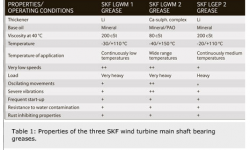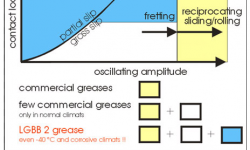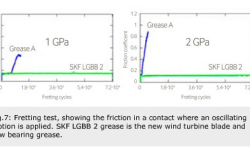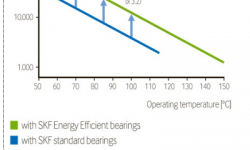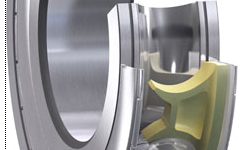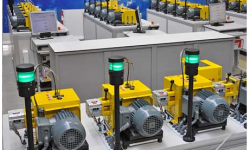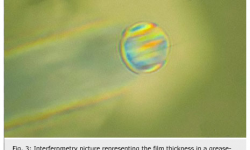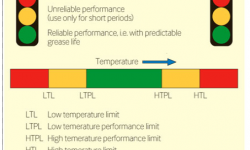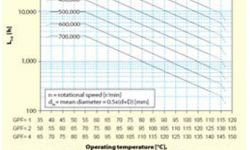
SKF grease knowledge & sustainability
Grease lubrication knowledge is vital for a bearing company. SKF is putting its knowledge of this area into creating new products and services that contribute to sustainability, energy efficiency and extended bearing life.
Summary
SKF has made steady progress in understanding all aspects of grease lubrication from both theoretical and practical viewpoints. This understanding has led to technical improvements for new products in a range of applications in industries as diverse as paper production and wind power generation. Overall, it is leading to energy-saving, sustainable and environmentally friendly solutions based on a deep knowledge of factors that affect bearing life and performance.
SKF’s R&D efforts are directed towards supporting product development in bearings and seals for which the understanding of grease lubrication is crucial, since most bearing failures are caused by improper lubrication.
SKF has in-house competence to analyze lubricants and the impact of lubrication on bearing performance by means of a broad range of sophisticated chemical, measuring and test equipment.
The lubricant and lubrication system is often integrated into the bearing system where specific greases are chosen, dedicated to the application. SKF does not manufacture grease but, in partnerships with preferred suppliers, has developed a range of greases, both for initial fill and the aftermarket.
Lubrication knowledge also extends to automatic lubricators, multi-point and single-point lubricators, centralized lubrication systems and total-loss and circulating centralized lubricating systems.
SKF also provides training in lubricant selection, lubricant handling, inspection, disposal and reliability maintenance. A separate SKF business unit, Engineering and Consultancy Services, helps to develop products relating to rotating shafts or bearing applications. Obviously, lubrication (especially grease lubrication) is very important here. Application engineering, consultancy services, training, lubrication management, condition monitoring, reliability maintenance, technical support, tools, products and systems together form the complete SKF lubrication solution.
GREASE LUBRICATION FOR BEARING APPLICATIONS
The perfect bearing would be lubricant free. However, lubricant is needed to separ-ate the rolling elements from the raceways in order to prevent damage due to (micro) slip. The ideal separating medium is liquid, which is able to accommodate shear with low frictional losses and may replenish the bearing surfaces (self-healing action).
Lubricating grease is widely used for its consistency, which makes it easy to use; it will not easily leak out, and it provides some sealing action. Grease protects against corrosion and lowers friction values, compared with oil lubrication, provided that grease with a good quality and filling rate is applied.
A lubricating grease has a finite life [2,3], which is generally shorter than bearing fatigue life [1]. Advanced bearing life models exist, and as grease life often dominates bearing service life, a grease life model is highly desirable. Unfortunately, the complexity of grease lubrication [2] means that no physical models for the prediction of grease life are available today. SKF has developed an empirical model where grease life (or the relubrication interval) can be calculated for a “good-quality grease”.
For deep groove ball bearings, SKF has developed the Grease Performance Factor (GPF) concept [3] (se bild .1) for the prediction of life for well-known greases where data are available. A GPF=1 corresponds to the performance of a “good-quality grease”. Many grease types outperform the standard “good quality” and will have a GPF>1. se bild . 1 shows the grease life as a function of temperature, speed (n dm) and grease quality [3].
SKF recommends temperature performance limits well within standardized temperature limits (se bild . 2). In between the recommended performance limits, the “green zone” of the SKF traffic light concept, the grease will function reliably and grease life (and relubrication interval) can be determined [8]. Temperatures in the amber zone on both sides of the green zone should occur only for very short periods. With time, temperature, mechanical working, ageing and the possible ingress of contaminants, grease in a bearing deteriorates and loses its lubricating properties. After the initial grease fill during installation, additional grease relubrication can realize the desired service life. Three factors for relubrication are important to achieve reliability: grease type, grease quantity and frequency of application. The supplied quantity and frequency of the greasing depends on the operating conditions and the supplying method: manually, or by an automatic lubricator or lubricating system. This knowledge is embodied in expert systems: LubeSelect, LuBase and DialSet, available through the Internet.
GREASE LUBRICATION PHYSICS
Understanding the physics and chemistry of grease lubrication is crucial in predicting grease performance in a bearing. Grease life testing under application conditions is usually impossible, as an application will be designed for a very long endurance, which would lead to unacceptably long testing times. In practice, test conditions are chosen to be more severe (e.g., higher temperature and/or higher speeds) than in the application. In addition, grease life test rigs are sometimes operated with standardized bearings, which differ from the application.
Lubricating grease performance depends not only on the grease properties, but also on the internal geometry of the particular bearing type. Even within bearing types, the performance depends on the internal geometry, where internal dimensions, sealing solution, cage conse bild uration and cage mater-ial are most important.
By knowing the physics and chemistry of lubricating greases, test results can be “extrapolated” to conditions for which test data are not available. Moreover, grease life test data are used to validate physical models developed for grease lubrication. SKF’s Engineering & Research Centre has developed state-of-the-art knowledge and models in tribology/lubrication and physics/chemistry, which support the understanding of grease lubrication. Scientific areas supporting the development of grease prediction models include rheology, fluid dynamics, chemistry, elasto-hydrodynamic lubrication and statistics.
In the early stage of bearing operation grease will flow. Most of the grease ends up adjacent to the raceways and some remains inside the “swept area”. Internal distribution of the grease inside the bearing during and after this phase requires understanding of fluid dynamics and the grease’s rheological properties. Applying fluid dynamics theory to grease flow is not simple; after all, a lubricating grease is not really a fluid. Grease ages by mechanical and thermal work, which is severe in a bearing, adding complexity to the problem. Fluid dynamics/rheology theory is also used to predict the oil-bleeding properties of grease. Understanding the chemistry in grease lubrication is important to predict the oxidation of base oil and thickener [4]. In addition, grease chemistry determines the boundary lubrication properties.
Lubricating grease is supposed to develop a separating film, which may be a boundary film or may be formed by hydrodynamic action. In rolling bearings, the elastic deformation of the bodies in contact will generate a favourable inlet geometry for film build-up, and this phenomenon is called “elasto-hydrodynamic lubrication” (EHL). This theory is well developed for oil lubrication but not yet for grease lubrication where the film thickness is dominated by the availability of lubricant on the running tracks (generally referred to as “starved EHL” [5]) and by thickener “particles”. se bild . 3 shows an interferometry picture of a grease-lubricated contact. The film is not smooth, due to thickener particles entering the contact.
Finally, the grease lubrication process is not deterministic. There is a statistical distribution in failures, which further complicates the prediction. SKF has developed a sound knowledge of Weibull statistics, which is used to evaluate bearing life and grease life test data [6].
GREASE TESTING
To predict lubricating grease life in a bearing, SKF has developed test machines that are used throughout the industry. Traditionally, these were the R0F (ball bearings) and R2F (spherical roller bearing) test rigs. The R0F test rigs have been upgraded (R0F+), making them very flexible in terms of speed, load and temperature. A large number of R0F and R0F+ can be found at the SKF Engineering & Research Centre, enabling 140 tests to be carried out simultaneously (se bild . 4).
In addition to grease life testing, functional testing is done on start-up torque, friction, corrosion resistance, vibrations (V2F), grease noise (BeQuiet+), etc. A well-equipped chemical lab supports the evaluation of the test results.
PRODUCT DEVELOPMENT AND GREASE LUBRICATION
Several examples demonstrate how understanding of grease lubrication has influenced new product development, including a new generation of SKF Energy Efficient bearings. se bild . 5 shows an SKF Energy Efficient (E2) deep groove ball bearing. SKF E2 deep groove ball bearings have frictional losses that are at least 30 % lower when compared with the same size standard SKF bearings. Developed for grease-lubricated applications, SKF E2 bearings also consume less lubricant.
Comparison between the grease life in a standard and SKF E2 deep groove ball bearing (se bild . 6) shows grease life is doubled, effectively doubling bearing service life. The friction reduction can be ascribed to improved grease lubrication, i.e., unique grease in combination with improved internal geometry and a new cage design. This is a good example of how grease development has been integrated into bearing design.
A new grease with excellent anti-false brinelling properties for wind turbine blade and yaw bearings arose when SKF developed its own in-house test rig and method for false brinelling. se bild . 7 plots the test results with a standard grease and the new blade and yaw bearing grease, where the friction is monitored as a function of the number of oscillations. If friction continu-ously increases over time, then failure is about to happen. The blue lines represent the measurements for commercial grease. The green lines are the measurements with the SKF LGBB 2 grease, which forms a protective tribo-layer and shows very low values of friction for many cycles and will lead to long service life in bearings.
se bild . 8 shows the window of operation for various greases in blade bearing-like conditions. In case of partial slip, the oscillation is so small that the centre of the Hertzian contact will stick, and slip only takes place on the edges of the contact. Gross slip takes place when the oscillations are so severe that even the centre of the contact will slide. Fretting typically occurs between surfaces intended to be fixed, however subjected to small oscillations and is characterized by generated wear debris that stay entrapped inside the contact area. The SKF LGBB 2 grease has excellent anti-fretting properties and can also be used for large oscillations. The grease performs well at low temperatures and has good anti-corrosion properties, making it very suitable for wind turbine blade and yaw bearing applications.
For paper mill applications, SKF has developed the “SKF polymer thickened lubricant”, or polymer grease, replacing traditional soap thickener with a polymer [7]. The polymer is non-polar, i.e., the soap does not compete with the metal surface to attract the additives. Conventional grease contains 10–20 % metal-based soap thickener (polar) and 80-90 % base oil, including the additive package. The polymer-thickened lubricant contains 10–13 % polypropylene (PP), a non-polar material, and 87–90 % oil, including the additive package. The unique process for the formation of polymer-thickened grease is the innovative heating and quenching operation of the polymer, which is dissolved in oil. This results in a three-dimensional net structure, which functions like a “normal”, metal-soap-thickened grease. The grease gives a long life on the R0F test rig, even in the absence of additives, making it more environmentally friendly with prolonged relubrication intervals. This will lead to reduced grease consumption. The new polymer grease has excellent low-temperature performance, and less energy is required in its production.
Grease requirements for the main shaft bearings in wind turbines relate to the harsh environment where the grease has to achieve high reliability under heavy contact loading, low speeds and oscillating and standstill conditions. Additional challenges arise for wind turbines installed in offshore and cold climates. SKF has developed three different greases for wind turbine main-shaft applications. Table 1 shows the greases’ properties. All three greases are widely used and approved by various wind turbine OEMs. The choice of grease depends on the type of sealing, operating conditions and environment.
SKF offers complete customer solutions for main shaft applications encompassing greases, housings, seals, bearing conse bild ur-ations, lubricating systems, lock nuts, mounting services, lubricants and analyses and condition monitoring.
CONCLUSIONS
SKF is contributing to sustainability and supporting environmentally friendly solutions through further development and application of its knowledge in grease lubrication, thus prolonging the service life of bearing systems and reducing friction, leading to less energy consumption. Extended service life and relubrication intervals lead to less need for maintenance and to a reduction of waste. This is achieved by using the knowledge obtained from fundamental R&D and model development in combin-ation with product development.
References
[1] E. Ioannides, G. Bergling, and A. Gabelli.
An analytical formulation for the life of rolling bearings. Acta Polytechnica Scandinavia, Mechanical Engineering Series, Finnish Academy of Technology, (137), 1999.
[2] P.M. Lugt. A review on grease lubrication in rolling bearings. Tribology Transactions, 52(4):470-480, 2009.
[3] B. Huiskamp. Grease life in lubricated-for-life deep groove ball bearings. Evolution, 2:26–28, 2004.
[4] A. van den Kommer and J. Ameye. Prediction of remaining grease life- a new approach and method by linear sweep voltammetry. Proceedings Esslingen Conference, pages 891–896, 2001.
[5] M.T. van Zoelen, C.H. Venner, and P.M. Lugt. Prediction of film thickness decay in starved elasto-hydrodynamically lubricated contacts using a thin-film layer model. Proceedings of the Institution of Mechanical Engineers. Part J, Journal of engineering tribology, 223(3):541-552, 2009.
[6] T. Andersson. Endurance testing in theory. Ball Bearing Journal, 217:14–23,1983.
[7] D. Meijer, D. Polymer thickened lubricating grease. European Patent Application,(EP 0 700 986 A3), 1996.
[8] SKF General Catalogue, 6000/I (2008)


